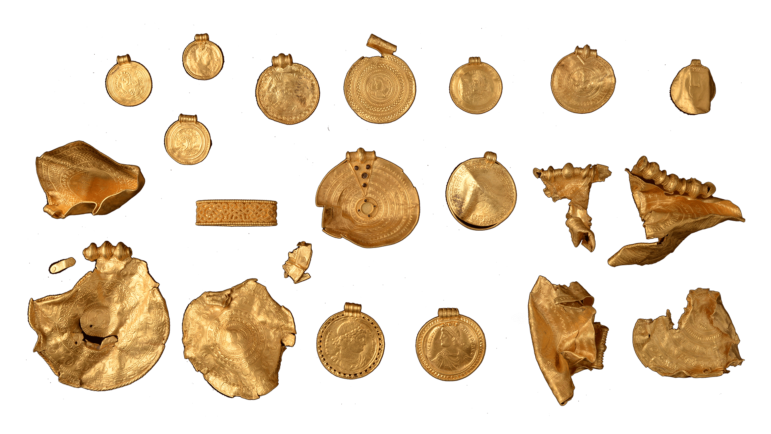JELLING, DENMARK – Last month, the Danish National Museum (Nationalmuseet) and the Vejle Museum (Vejlemuseerne) unveiled one of the most impressive finds of Iron Age gold yet discovered. The collection contains 22 objects, including Roman coins and many of the thin, amulet-like discs known as “bracteates.” Altogether, the collection weighs just over two pounds.
“This is the biggest find that has come in the 40 years I have been at the National Museum,” said Peter Vang Petersen, an archeologist with the Nationalmuseet to TV Syd. “We have to go back to the 16th and 18th centuries to find something similar.”
The collection is currently believed to originate from the middle of the 6th century, a period called the Migration Era, before the Viking Age. This is the time when similar hoards have been dated, including previously discovered bracteates. There were widespread famines and unusually cold weather in Europe in the year 536, potentially caused by a volcanic eruption, and some scholars believe hoards like this were buried as a religious offering to restore the sun. There could be more mundane explanations for why such a hoard came to be buried near Jelling, however.
Archeologists say that the find was buried in a longhouse. Mads Ravn, director of the Vejlemuseerne, believes this points to the area being a power center with extensive trade networks. “Only one member of society’s absolute top has been able to collect a treasure like the one found here,” he said in a statement to Agence France-Presse. “There was nothing that could make us predict that an unprecedented warlord or great man lived here, long before the kingdom of Denmark arose in the following centuries.”
For modern Pagans, the most intriguing specimen is surely a bracteate with an elder futhark runic inscription that depicts the face of a man and a horse. One inscription reads “houaʀ,” which translates to “The High One.”

The “houaʀ” bracteate, with the face of a man and the shape of a horse outlined [Vejlemuseerne]
Morten Oxboe, a retired curator at the Nationalmuseet and expert on bracteates, argues the bracteate may be a reference to a myth involving Odin, who is famously called “The High One” in the Old Norse-Icelandic poem “Hávamál,” written down in the 13th century Iceland. In the Second Merseburg Charm, Odin is able to heal his son Balder’s horse, which had broken its leg and would soon die, after several goddesses are unable to do so; Odin is able to mend the horse’s leg by means of sympathetic magic:
Phol and Wodan were riding to the woods,
and the foot of Balder’s foal was sprained
So Sinthgunt, Sunna’s sister, conjured it;
and Frija, Volla’s sister, conjured it;
and Wodan conjured it, as well he could:Like bone-sprain, so blood-sprain,
so joint-sprain:
Bone to bone, blood to blood,
joints to joints, so may they be glued.(translation from Benjamin W. Fortson, Indo-European language and culture: an introduction, Wiley-Blackwell, 2004.)
The Second Merseburg Charm, however, is in Old High German and was recorded in a manuscript from the 9th or 10th century in Fulda, Germany – many centuries and many miles away from the time the hoard was buried near Jelling. As such, while the potential connection between “The High One” and the Viking Age Wodan/Odin is tantalizing, it should not be taken as conclusive.

Items from the gold hoard [Vejlemuseerne]
The story of the hoard’s discovery is just as fascinating. Ole Ginnerup Schytz had just acquired a metal detector and had taken it to a friend’s land near the town of Vindelev to prospect for the first time. The device activated within the first few hours. “Denmark is 43,000 square kilometers, and then I happen to choose to put the detector exactly where this find was,” said Schytz to TV Syd.”
He uncovered a small piece of bent metal. “It was scratched and covered in mud,” he told TV Syd. “I had no idea, so all I could think of was that it looked like the lid of a can of herring.”
Since metal detectors became readily available in the 1980s, amateur archeologists have made the majority of new finds in Denmark. Under Danish law, amateurs like Schytz can turn their findings over to the Nationalmuseet and are compensated based on a number of factors, which encourages them to offer their findings to scholars rather than try to sell them illicitly. Schytz’s compensation has not been divulged.
“I told him he might as well just sell the detector now because he already peaked,” said Ravn. “It doesn’t get better.”
The hoard will go on display at the Vejlemuseerne in February, where it will remain for a year before transitioning to the Nationalmuseet.
The Wild Hunt is not responsible for links to external content.
To join a conversation on this post:
Visit our The Wild Hunt subreddit! Point your favorite browser to https://www.reddit.com/r/The_Wild_Hunt_News/, then click “JOIN”. Make sure to click the bell, too, to be notified of new articles posted to our subreddit.